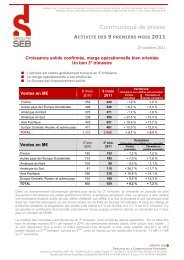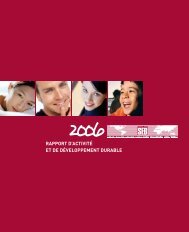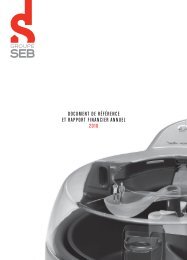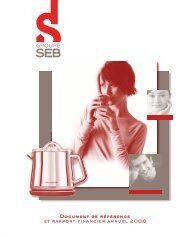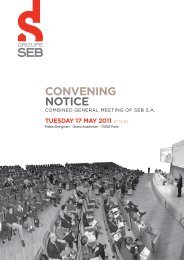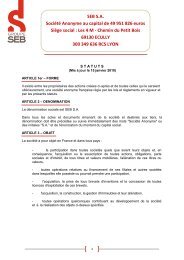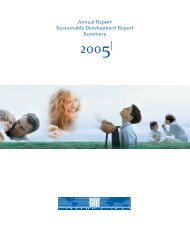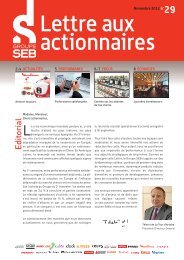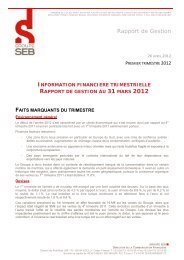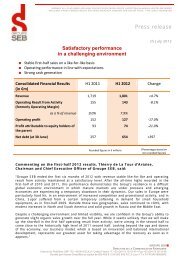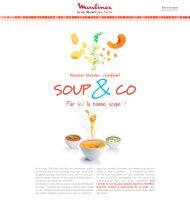financial report and registration document 2011 - Groupe SEB
financial report and registration document 2011 - Groupe SEB
financial report and registration document 2011 - Groupe SEB
You also want an ePaper? Increase the reach of your titles
YUMPU automatically turns print PDFs into web optimized ePapers that Google loves.
Raw materials<br />
The Group’s business is exposed to fl uctuations in the price of certain raw<br />
materials, including metals such as aluminium, nickel (used in stainless steel)<br />
<strong>and</strong> copper. In recent years, the markets have been extremely mixed <strong>and</strong><br />
variable. After a “high” cycle in 2007 <strong>and</strong> early 2008, during which prices<br />
reached record highs, the crisis in late 2008 <strong>and</strong> 2009 caused these prices to<br />
turn sharply downwards. When infl ation picked up again in late 2009, this led<br />
to a marked, uninterrupted increase in metal prices. This increase was very<br />
much linked to the economic recovery, <strong>and</strong> particularly to the rapid rise in<br />
Chinese dem<strong>and</strong>, which put heavy pressure on commodities with impacts on<br />
prices. The weakening of the general economic climate <strong>and</strong> the recurrence of<br />
a serious crisis situation in mid-<strong>2011</strong>, with, in particular, concerns regarding<br />
the ability to maintain strong growth in the emerging markets (<strong>and</strong> especially<br />
in China), greatly impacted prices beginning in the summer. Metal prices thus<br />
experienced a signifi cant <strong>and</strong> steep drop beginning in the summer of <strong>2011</strong>.<br />
In <strong>2011</strong>, the infl ation seen in the fi rst half of the year, followed by the decline<br />
during the last four months of the year, ultimately resulted in a 10% increase<br />
in the price of aluminium, with an average price of $2,395 per metric ton<br />
(vs. $2,173 in 2010). In practice, the Group mostly buys aluminium discs for<br />
which all price components – metal LME price, access bonus <strong>and</strong> added<br />
value – increased considerably in <strong>2011</strong>. Nickel also fi nished the year on a<br />
high note, increasing 5% over 2010 with an average price of $22,800 per<br />
metric ton ($21,800 in 2010). As for copper, it was driven by an infl ationary<br />
spiral throughout the year that pushed it up 17% to an average price of<br />
$8,800 per metric ton in <strong>2011</strong>, versus $7,540 in 2010. The downturn seen in<br />
First bond issue<br />
In May <strong>2011</strong>, the Group carried out its fi rst bond issue, totalling €300 million,<br />
with a term of fi ve years (maturing on 3 June 2016) <strong>and</strong> an annual coupon<br />
rate of 4.5%. The issue was largely over-subscribed (€600 million), attesting<br />
both to investor confi dence <strong>and</strong> their taste for the inaugural bond offering.<br />
Continued expansion in emerging markets<br />
In <strong>2011</strong>, <strong>Groupe</strong> <strong>SEB</strong> pursued its strategy of expansion into emerging<br />
economies with three major transactions. These acquisitions aimed to<br />
strengthen the Group’s international infrastructure, especially in markets<br />
experiencing rapid growth <strong>and</strong> with high potential over the medium term.<br />
� After signing an agreement on 17 December 2010 with the Company’s<br />
founding family, on 28 February <strong>2011</strong> <strong>Groupe</strong> <strong>SEB</strong> acquired Colombiabased<br />
Imusa. This company manufactures <strong>and</strong> markets cookware<br />
made of aluminium, stainless steel <strong>and</strong> cast aluminium (frying pans,<br />
saucepans, stockpots, regional cooking pots known as calderos, pressure<br />
cookers, etc.) as well as plastic items for the home <strong>and</strong> kitchen including<br />
Financial Report <strong>and</strong> Registration Document <strong>2011</strong><br />
4<br />
Commentary on the fi nancial year<br />
<strong>2011</strong> highlights<br />
the last months was not enough to disrupt the rising price of metals for the<br />
year, which was detrimental to the Group. It should be recalled, nonetheless,<br />
that in order to smooth out the effect of these variations, the Group has<br />
implemented a hedging policy for some of its metal needs.<br />
As regards plastics, after two years of sharply increasing prices, up<br />
to September <strong>2011</strong>, the trend slowed down in late <strong>2011</strong>. On average,<br />
however, the increase in plastics prices stood at 10-25% for the year,<br />
depending on the category. As the Group sourced most of its plastic parts<br />
pre-formed, the impact of the increase on purchasing was somewhat diluted.<br />
Nevertheless, the average prices paid by the Group in <strong>2011</strong> for purchased<br />
materials, components <strong>and</strong> sub-systems were much higher than in 2010,<br />
in spite of the hedging contracts in place. Sourced fi nished products also<br />
became more expensive due to the appreciation of the Chinese yuan <strong>and</strong><br />
higher salaries in China. The <strong>2011</strong> purchasing index matched the Group’s<br />
expectations <strong>and</strong> was 3.5 points higher than the 2010 index.<br />
The Brent price increase in <strong>2011</strong> had only a limited impact on sea transport<br />
costs, which are also subject to the laws of supply <strong>and</strong> dem<strong>and</strong>. Due to the<br />
decline in consumer spending in certain mature markets (United States,<br />
Europe) <strong>and</strong> the implementation of additional capacities planned well before<br />
<strong>2011</strong>, maritime traffi c between Asia <strong>and</strong> these two regions decreased, leading<br />
to a drop in prices. As for air <strong>and</strong> road freight, these forms of transportation<br />
were subject to a fuel surcharge (diesel fuel), generally leading to a rise in<br />
prices.<br />
The issue enables <strong>Groupe</strong> <strong>SEB</strong> to lengthen the average maturity of its debt<br />
<strong>and</strong> diversify its sources of fi nancing, in addition to its existing lines of credit,<br />
while taking advantage of an attractive fi nancing opportunity. The bonds are<br />
traded on the Euronext Paris market.<br />
storage containers, kitchen utensils, thermos fl asks, etc. Imusa’s 2010<br />
sales amounted to €90 million, with 57% of these sales coming from the<br />
Colombian market <strong>and</strong> 28% from the United States, <strong>and</strong> the remainder<br />
from various markets within Latin America. A leader in the Colombian<br />
market with two br<strong>and</strong>s, Imusa <strong>and</strong> Umco (focusing more on the entrylevel<br />
segment), the company has two production units, two sales offi ces<br />
(in Colombia <strong>and</strong> in the US) <strong>and</strong> employs around 1,000 people. At the<br />
time of the acquisition, Imusa had 12 of its own retail outlets, plus two<br />
new stores that opened in <strong>2011</strong>. Through Imusa, the Group has affi rmed<br />
its leadership in the small domestic equipment segment within the very<br />
dynamic Colombian market. <strong>Groupe</strong> <strong>SEB</strong>’s Samurai br<strong>and</strong> was already<br />
GROUPE <strong>SEB</strong><br />
4<br />
61



